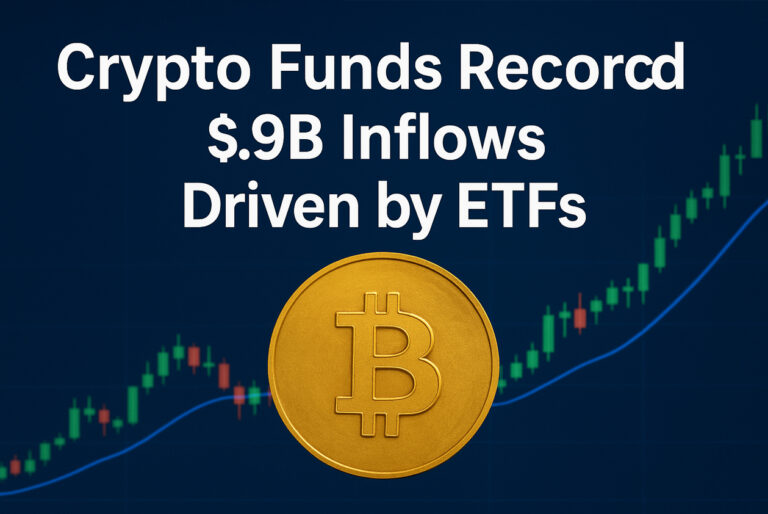Premium Biz Post – The cryptocurrency market is regaining its momentum as investors return with renewed enthusiasm. Recent reports reveal that crypto funds record $1.9B inflows driven by ETFs, marking one of the strongest capital movements in the digital asset space this quarter. This surge, largely fueled by Bitcoin exchange-traded funds (ETFs), demonstrates a clear shift in investor sentiment from caution to optimism amid evolving global economic conditions.

A Remarkable Turnaround in Crypto Investment Flows
The digital asset market, which had faced volatility over the past few months, is showing strong signs of recovery. According to the latest data from CoinShares, the past few weeks have seen a net inflow of $1.9 billion into crypto investment products. This represents a consistent upward trend from previous weeks, indicating growing institutional participation and retail investor confidence.
Bitcoin remains the primary beneficiary, accounting for over 80% of the total inflows. The rise of regulated investment vehicles such as ETFs has played a crucial role in attracting institutional investors who prefer exposure to digital assets through safer, compliant structures. Ethereum and Solana also saw moderate inflows, signaling a diversified interest across the crypto ecosystem.
ETF Adoption: The Catalyst Behind the Surge
Exchange-Traded Funds (ETFs) have fundamentally transformed how investors approach cryptocurrency. Before their introduction, direct crypto investment posed significant hurdles, including custody risks, tax complexities, and regulatory uncertainties. ETFs offer an accessible and compliant way for both institutional and retail investors to gain exposure to digital assets without directly holding them.
The approval and expansion of Bitcoin ETFs in several jurisdictions, including the U.S. and parts of Europe, have been game-changers. These ETFs provide transparency, liquidity, and security—qualities that traditional investors demand. With new ETFs entering the market every month, total assets under management (AUM) for crypto-related funds have reached new all-time highs.
According to market analysts, ETF-related products now account for nearly 60% of total institutional inflows into crypto assets. This surge not only demonstrates growing trust in digital assets but also reflects a maturing regulatory environment that continues to shape the future of cryptocurrency investment.
Bitcoin Leads the Way
Bitcoin continues to dominate the crypto investment landscape. Of the $1.9 billion inflows, approximately $1.5 billion were allocated to Bitcoin-based funds. The inflows coincide with renewed expectations surrounding the next Bitcoin halving event, anticipated in mid-2026, which historically correlates with significant price appreciation.
Institutional players, such as hedge funds and asset management firms, are increasingly viewing Bitcoin as a digital alternative to gold—a hedge against inflation and macroeconomic uncertainty. Michael Saylor’s MicroStrategy, for instance, recently added nearly $100 million worth of Bitcoin to its holdings, reaffirming its long-term bullish stance on the asset.
The rising demand for Bitcoin ETFs suggests that mainstream investors are beginning to accept Bitcoin as a legitimate component of a diversified investment portfolio. With improved regulatory clarity, the market could be on the verge of a prolonged bullish phase.
Ethereum and the Rise of Altcoins
While Bitcoin captures most of the spotlight, Ethereum and select altcoins are also benefiting from renewed market enthusiasm. Ethereum-based funds recorded modest inflows of $120 million, driven by growing optimism surrounding Ethereum 2.0 scalability upgrades and the potential expansion of decentralized finance (DeFi) applications.
Solana, a high-performance blockchain known for its low transaction costs, attracted roughly $40 million in inflows during the same period. These movements suggest that investors are diversifying within the crypto market, exploring assets that combine strong technological foundations with increasing real-world use cases.
DeFi platforms, non-fungible tokens (NFTs), and Web3 ecosystems continue to evolve, driving utility and long-term adoption across multiple blockchain networks. As a result, analysts predict a broader rebound in altcoin performance over the coming months.
Read More : ”The Art Carving and Sculpture Transforming Hard Materials into Timeless Works’‘
Institutional Confidence Returns
Institutional investors are once again becoming a driving force in the cryptocurrency market. Following a period of uncertainty caused by regulatory crackdowns and global inflationary pressures, professional investors are returning to digital assets with renewed interest.
Several leading financial institutions, including BlackRock, Fidelity, and VanEck, have expanded their crypto product offerings, signaling mainstream acceptance. The steady inflows into crypto ETFs highlight how regulated frameworks have successfully lowered the perceived risk associated with digital assets.
Furthermore, custodial solutions and blockchain auditing tools have enhanced security and transparency, making institutional adoption more feasible than ever. This convergence of technology and regulation marks a pivotal moment for the crypto industry, setting the stage for sustainable growth.
Regulatory Evolution and Market Stability
Regulatory clarity remains one of the most influential factors in shaping the crypto market’s trajectory. Over the past year, major economies have introduced clearer guidelines for crypto taxation, anti-money laundering (AML) compliance, and investor protection. These frameworks are building investor trust and legitimizing the digital asset class on a global scale.
The U.S. Securities and Exchange Commission (SEC) recently approved standardized listing requirements for cryptocurrency-based ETFs, a move that could pave the way for an influx of new investment products. This regulatory advancement has been widely viewed as a milestone, helping bridge the gap between traditional finance and blockchain technology.
Countries in Asia and the Middle East are also accelerating their digital asset policies, establishing dedicated regulatory sandboxes and government-backed crypto initiatives. As a result, the global regulatory landscape is becoming more coherent, reducing uncertainty and enabling institutional investors to commit larger capital allocations.
Market Outlook: Signs of a New Bull Run?
The recent $1.9 billion inflow has sparked speculation that the crypto market may be entering the early stages of a new bull cycle. While short-term volatility remains inevitable, several fundamental indicators point toward sustained growth.
Blockchain activity is rising across major networks, stablecoin circulation is increasing, and on-chain data shows a steady accumulation trend among long-term holders. Analysts believe that if macroeconomic conditions stabilize and central banks begin easing monetary policy, digital assets could benefit from renewed liquidity and risk appetite.
In addition, the growing integration of artificial intelligence (AI) and blockchain is opening new frontiers for decentralized computing, data security, and tokenized assets—factors that could drive innovation and adoption in the next decade.
Challenges Ahead
Despite the positive momentum, the crypto market continues to face challenges. Regulatory inconsistencies between jurisdictions, cybersecurity risks, and occasional market manipulation remain pressing issues. Moreover, the ongoing debate surrounding the environmental impact of Bitcoin mining could resurface as a focal point of public concern.
Investors must remain cautious, adopting long-term strategies while staying informed about market developments and policy changes. The volatility that characterizes the crypto market can present both risks and opportunities, depending on how investors navigate it.
The report confirming that crypto funds record $1.9B inflows driven by ETFs underscores the resilience and growing maturity of the digital asset market. Fueled by institutional confidence, regulatory advancements, and technological innovation, the crypto industry appears poised for its next growth phase.
Bitcoin remains the dominant force, but the diversification into Ethereum, Solana, and other assets reflects a healthy, expanding ecosystem. With ETFs bridging the gap between traditional finance and digital innovation, crypto’s journey toward mainstream adoption seems increasingly inevitable.
As global investors look for alternative stores of value and new avenues for growth, cryptocurrencies are once again emerging as a powerful contender in the modern financial landscape.



